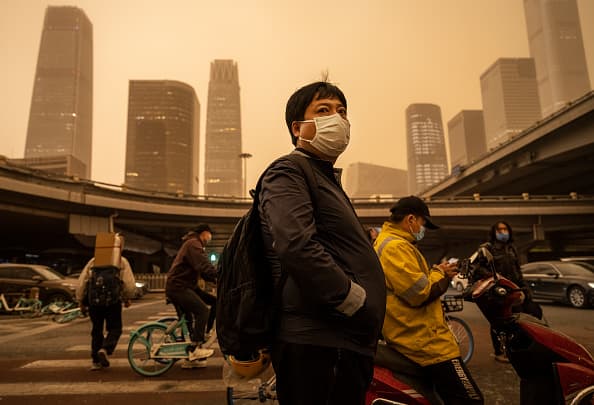
A commuter wears a protective mask as they wait at a traffic light during a seasonal sandstorm on April 15, 2021 in the Central Business District in Beijing, China.
Kevin Frayer | Getty Images News | Getty Images
China, the world’s largest carbon emitter, has made commitments to climate change and set ambitious targets to reach carbon neutrality by 2060. But, so far, details on how to get there have been scarce.
Like many other large countries, China missed a July 30 deadline to submit new climate pledges to the United Nations.
That may change at COP26 this year, the 26th UN Climate Change Conference of the Parties, according to Gavin Thompson, vice chairman of Wood Mackenzie Asia Pacific.
Chinese President Xi Jinping has reportedly received a personal invitation to COP26, but has not confirmed his attendance.
In a Sept. 2 blog post, Thompson outlined five things to expect from China at the upcoming summit in the Scottish city of Glasgow.
Provide a roadmap
Formally submitting China’s national climate goals before COP26, which begins on Oct. 31, is a “critical step” that Beijing now seems ready to take.
“We should expect much more on how this will be achieved, with key targets for all of China’s provinces and sectors of the economy,” Thompson wrote.
To reach its 2060 net-zero carbon emissions goal, Wood Mackenzie expects that China needs an almost “complete transformation of how energy is produced and delivered,” he added.
Demand flexibility
Despite pressure from the international community, China has insisted on charting its own course to net-zero emissions and will continue to do so, Thompson said.
Coal-fired plants in China are unlikely to be banned anytime before 2025, he predicted. The country’s five-year plan still includes support for carbon-intensive coal.
“The twin goals of energy security and economic growth will drive China’s push for flexibility in meeting targets,” he said.
Still, China has been investing in renewable and clean energy as it works toward its target for carbon dioxide emissions to peak by 2030.
Oppose carbon border tax
Pressure richer countries
China has long believed that the responsibility to reduce global emissions rests with more developed countries, Thompson said.
“You broke it, you fix it,” he wrote of Beijing’s stance, adding that their position “is not without justification.”
Pushing the blame to richer nations also has potential economic benefits for China because it dominates the supply and processing of most of the raw materials for clean technologies.
“By heaping pressure on developed nations to more urgently address climate change, both at home and through increased financial support to poorer countries, Beijing is banking on much of the economic benefits likely flowing back to China,” the WoodMac note said.
Position itself as a leader
Beijing attempted to present itself as a global leader on climate change in 2020 when the Trump administration left that position empty, Thompson wrote. Under former President Donald Trump, the U.S. withdrew from the Paris climate change agreement that was signed in 2015.
But with the Biden administration taking a “radically different approach,” China will now need to work harder to become a genuine leader.
“This should encourage bolder policies on carbon and technology, as without these, China’s reputation and global standing could be eroded by U.S. ambition,” he wrote.
The U.S. and China held talks on climate change last week, but tensions between the two sides came to the fore when Chinese Foreign Minister Wang Yi said cooperation on climate action cannot be separated from the wider relationship, Reuters reported.
U.S. climate envoy John Kerry responded by telling Chinese leaders that climate change was more important than politics.




